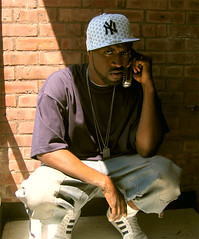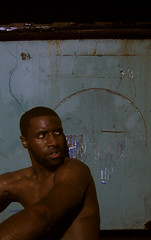On the Dissertation Tip
Well folks, it's a watershed moment in the life of your boy LarryLy. After 4+ years of coursework, qualifying exams and teaching, I've finally arrived at the place I've been dreaming about since I decided on a career in the academy: DISSERTATION STAGE!
Because the debates and discussions on this blog have been instrumental in preparing me to think critically about the intersection of text and image as it relates to issues of race, class and gender in 20th Century America, I am excited to share with you the first portion of my dissertation research -- an ambitious engagement of the work of African-American photographer Gordon Parks alongside that of folklorist/author Zora Neale Hurston.

Gordon Parks’ rise as a documentary photographer allowed him to intervene in the revision of America’s national identity during a crucial moment in the country’s history: the advent of mass culture in the 1930s. Pursuing the Farm Services Administration’s goal of “introducing America to Americans,” Parks’ early work exposed the infringement of mass culture upon local cultures, particularly the ways in which farm mechanization signaled major changes in the profile of working-class labor.
My research explores the conversation between Zora Neale Hurston’s Mules and Men (1935) Their Eyes Were Watching God (1937) and Dust Tracks on a Road (1942) and Parks’ work with the FSA. I am particularly interested in the possible relationships between black laborers’ experiences of the Farm Services Administration and the Federal Security Administration, which scholars have discussed in terms of its interventions in the town of Belle Glade, Florida (the town upon which Hurston bases her fictional accounts of “the muck”). How might these identically acronymed government programs have come to represent the heavy-handed surveillance of white capitalism for black rural laborers during the 1930s and 1940s? And how might this connection revise popular beliefs about the laborers’ relation to the white capitalist authority structure?
I argue that Hurston’s texts and Parks’ images help us discern how the economic shifts of the early 20th century impacted visual and literary interrogations of (and challenges to) white male hegemony and how that process impacted the emergence of the black middle class.




9 Comments:
The good stuff! The writing.
So, your final paragraph on this--how exactly is the "black middle class" sutured to Parks, who I don't know very well, but, most especially, to Hurston, whose work is anything but focused on the black middle class?
I'm guessing, on some level, this is a continuation of Gates's argument on the function of representation in creating "the black middle class" during the early part of the 20th C? A project that continues through the Crisis (Daylanne English on this) and now, you seem to suggest yet another iteration? It's the history that's tripping me up (courtesy of a friend, I'm obsessed with Williams's dominant, residual, and emergent, as ways of thinking through impacted histories--like impacted teeth).
But this all sounds good! My visual theory extends to telling my students that Harold Jackman was very hot. And showing pictures of him.
Thanks for the question, man. You're the best.
1. I actually think Their Eyes Were Watching God" is deeeeeply concerned with the emerging Black middle class. After all, isn't part of what makes Janie's departure from Eatonville so dramatic that she willfully eschews her economic security and enviable position as the wife of the late mayor to live amongst migrant laborers in the Everglades? Janie's willful, repeated transgressing of the trajectory of upward mobility is central to understanding a novel so concerned with how class informs interpersonal relationships in all-Black communities.
2. I'm not arguing that either Hurston or Parks are consciously intending to use their work to build to build the black middle class per se, but rather that the works of both Hurston and Parks helped move the black working class from the periphery of the national imagination to its center, forcing us to recognize the value of their labor (and personhood?) at precisely the same time that the pressures of new industrial unions and the needs of economic mobilization for World War II caused the discriminatory barriers that had kept blacks out of many industrial jobs began to fall.
As Parks moves from photographing rural laborers with the FSA (1935-1942) to shooting images for the Standard Oil Company of New Jersey (1945-1948)and later to doing photo editorials on the staff of Life Magazine (1948-1968), I think his career trajectory illustrates how his own upward mobility is made possible by/occurs in tandem with the rise of the Black middle class.
Hurston's story is a bit different, of course and I don't feel as comfortable discussing the cultural & political drama surrounding her work sliding into obscurity for 20 years. I suspect, however, that this is where I'll be addressing the intersection of race, gender and class most aggressively - 'cause a Black woman writing in dialect in the 30s and 40s was bound to enjoy less (sustained) acclaim than a figure like Parks.
Come what may, I do think H&P's challenges to white male hegemony [coupled with the economic shifts of the era] helped make the evolution of the black middle class visible and possible.
Okay,
so, if I can re-frame a little (stop me when I get obnoxious--and we can also do this over email if you prefer)
Your focus is on a rural-based middle class, a designation that was unimaginable, both in the urban-centric world of the Crisis (and the Du Bois of Souls is relentlessly urban-centric) and the ostensible world of study (so, E. Franklin Frazier writes in the Crisis about the "crisis" of black rurality, its already always dysgenic nature). And the list can go on: Toomer, Larsen, even Hughes.
What, then, does it mean to imagine a black rural middle-class? How does it fracture and re-orient assumptions that bind race and class to place, primarily urban locations?
Is this somewhere near something? Again, I know this is work in progress, and you probably do NOT want to disclose too much, so we can totally move to email.
Keguro
No, really. You rock.
The focus of this chapter is the evolution of rural working-class labor. I am not suggesting that elevated socioeconomic positions in a town like Eatonville equated to or produced an identifiable middle-class that was conversant with or comparable to the urban middle-class. What I am hoping to illustrate is the overlap in representations of the infrapolitics that shape relationships between black laborers as well as black working class folks' modes of resistance to bourgeois values.
As I move through chapters, I hope to be able to address your very important question about race, class and geography. Perhaps I should mention my forth chapter, which will pair Ann Petry's The Street (1946) with the photography of James VanDerZee. The shift from Belle Glade, Florida to New York City will enable me to discuss the ways in which my selected authors and artists challenge (or promote) the centrality of the Urban in the national imagination.
All that to say -- your question challenges me to think/strategize about how ambitious I want to be in discussing the [possibility of a] black rural middle-class. I appreciate it.
Feel free to keep this conversation going here. As I continue to refine my arguments, I hope to use this blog as a virtual works-in-progress talk of sorts and this is a great start.
Do email me though. I wanna chat about what you think I should be reading!
for anyone who wants to chat about the project but doesn't care to do it here, feel free to email me at ldlyons@princeton.edu
two of my favorite artist... i would definitely be interested in reading your work when you are done
Congrats, Larry!
Yessir Larry. Zora Neale Hurston is a great author. I wish you well brother with your completion! Very interesting concepts that you have put together.
Loving this, I am. Just one note about Du Bois -- his early novella "Tom Brown at Fisk" ends with Tom Brown becoming a prosperous farmer and his wife, Ella, being a teacher. The focus on the urban middle class comes after his own move to New York.
Post a Comment
<< Home